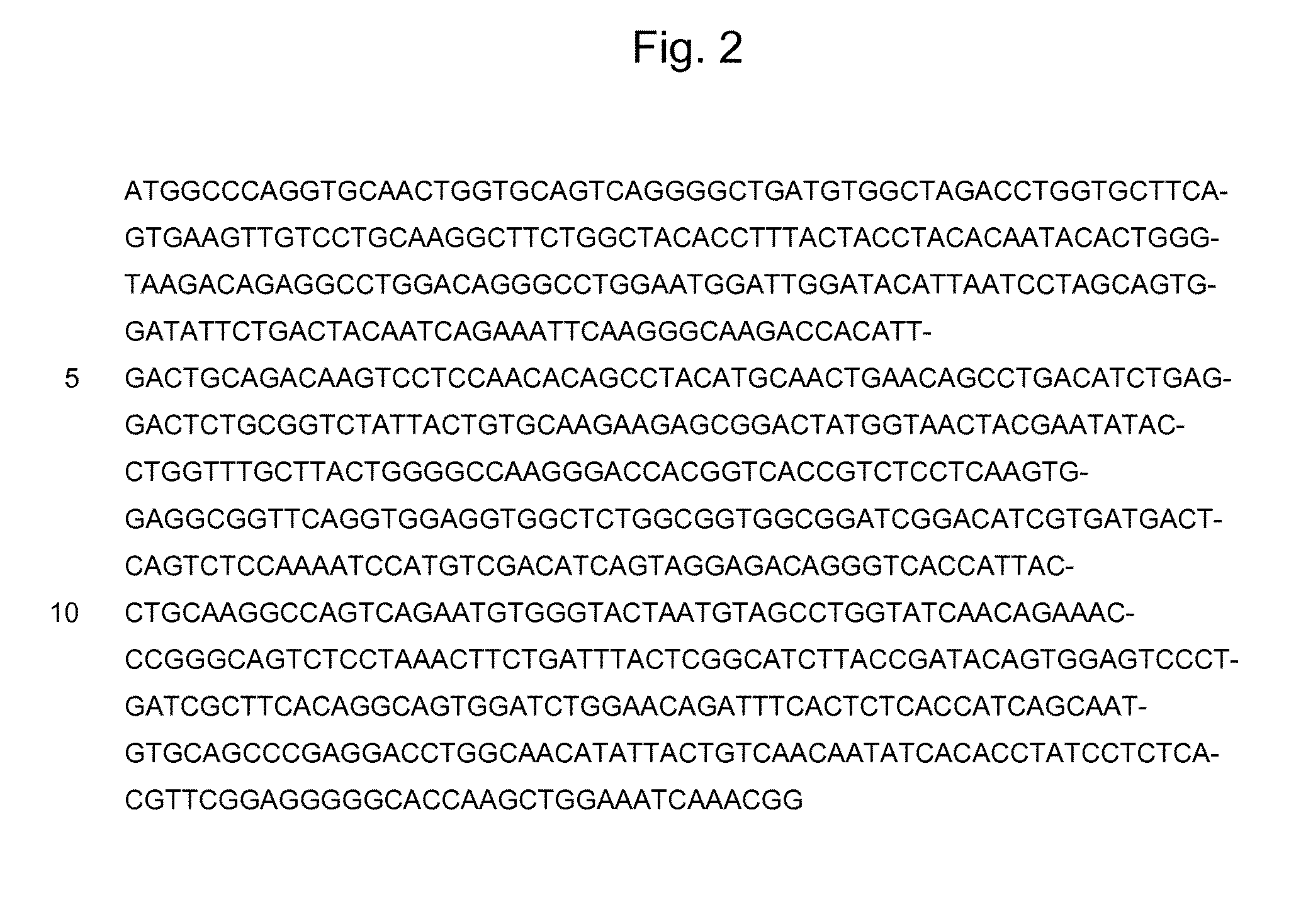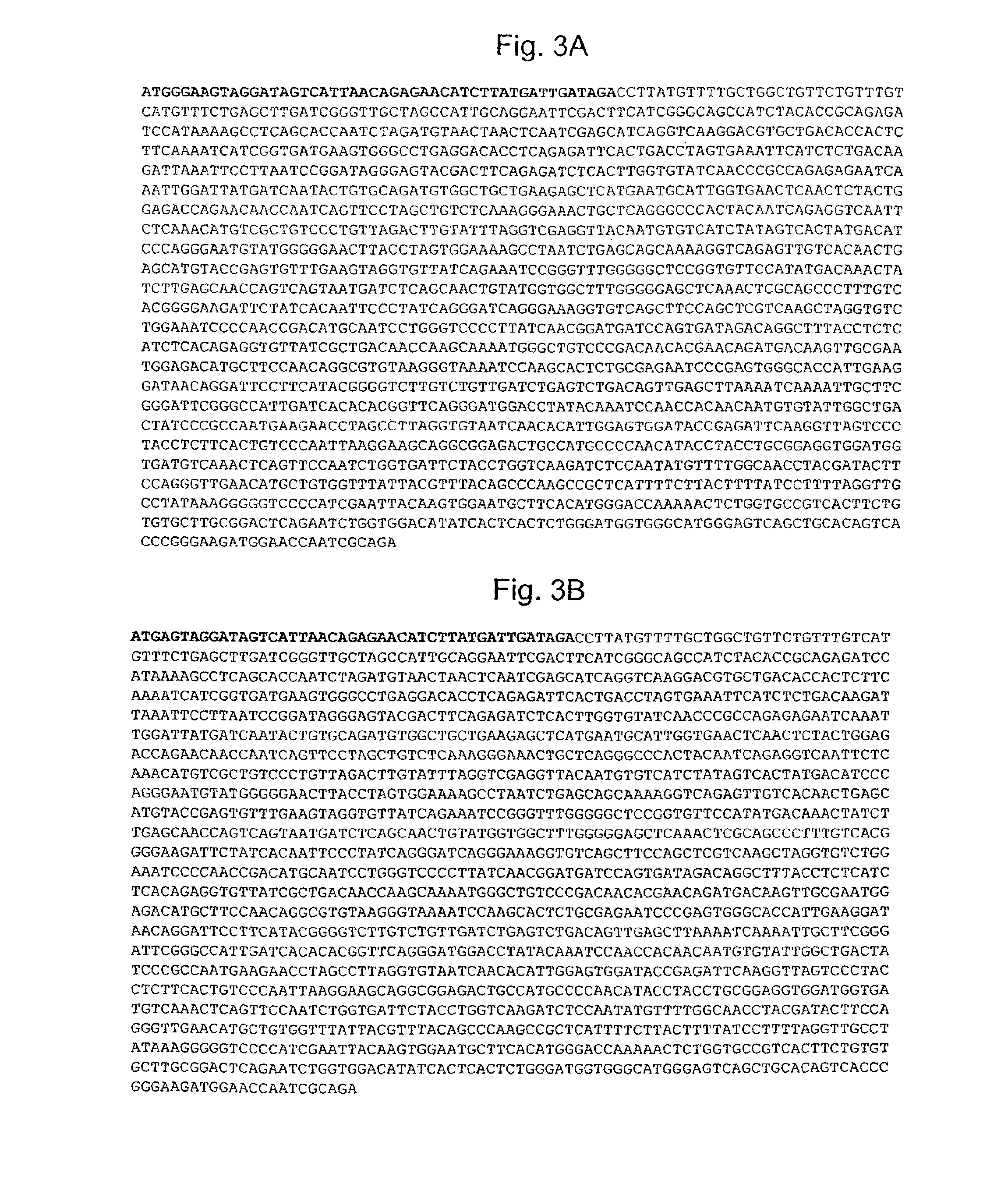Novel pseudotyped lentiviral particles and their use in the in vitro targeted transduction of undifferentiated pluripotent human embryonic stem cells and induced pluripotent stem cells
a technology of pseudotypes and lentiviral particles, which is applied in the field of pseudotypes of lentiviral particles, can solve the problems of inefficient current methods, and toxic to ipscs, and reducing the stem cell characteristics of cells
- Summary
- Abstract
- Description
- Claims
- Application Information
AI Technical Summary
Benefits of technology
Problems solved by technology
Method used
Image
Examples
example 1
Production and Isolation of Pseudotyped Lentiviral Vector Particles Displaying scFV-CD30
[0072]As described in WO / 2008 / 037458, the scFv anti-CD30 coding sequence was genetically fused to the modified coding sequence of measles virus hemagglutinin (H) protein. The scFv framework was modified as described in the previous patent application EP 11151018.6. Clone pHL3-CD30mut2#2 mediated a high titer and was used for further experiments. The transfection method for the production of vector particles is described in Anliker, B. et al. (Nat. Methods, 2010, 7: 929-935). Briefly, HEK-293T cells were transfected using poly-ethylene-imine (PEI). For this purpose, 1.5×107 cells were seeded 24 h before transfection into a T175 flask. Before transfection, the medium was replaced with 15 ml of Dulbecco's modified Eagle medium (DMEM) supplemented with 2 mM glutamine. In total, 2.6 μg of measles virus H protein expression plasmid, 8 μg of measles virus fusion (F) protein expression plasmid, 28.7 μg o...
example 2
Cultivation and Transduction of iPSCs
[0074]iPS cells are maintained on an inactivated feeder layer of murine embryonic fibroblasts in the presence of 20% Knock-Out (KO) Serum replacement, 1 mM non-essential amino acids, 1 mM L-glutamine, 0.1 mM β-mercapto-ethanol, 50 U penicillin / 50 μg streptomycin (Pen / Strep) and 8 ng / ml basic fibroblast growth factor (bFGF or FGF2) in KO-DMEM. For subcultivation, medium was removed and collagenase (2 mg / ml Collagenase Type IV in KO-DMEM) was added for 5 min to dissolve the stem cell colonies from the feeder layer. Subsequently, 1 ml medium was added to wash the colonies from the feeder layer and the colonies were concentrated by centrifugation (3 min, 800 rpm, 4° C.). The cell pellet was resuspended in an appropriate amount of fresh medium and allocated to fresh feeder plates.
[0075]For the transduction of iPS cells, an appropriate amount of colonies was seeded two days before transduction. To 1 ml cell culture medium, 10 μl of vector stock (titer:...
example 3
Cell Entry Targeted Lentiviral Vector Particles Directed to CD30-Expressing Cells
[0077]1.6×105 of the iPS cell lines hFFBiPS SB4 and hFFBiPS SB5 were seeded on a feeder layer of mouse embryo fibroblasts in a 24-well-plate. Transduction followed 24 h later with vesicular stomatitis virus G protein (VSV-G) pseudotyped lentiviral vectors (VSV-G-LV) and CD30opt-LV (MOI 0.1; 1 and 10 [only VSV-G-LV]) in 500 μl stem cell medium. After 6 h, medium was changed and cells were cultivated for 120 h. The eGFP-expression of transduced cells was analysed by fluorescence microscopy (FIG. 6A). For immunofluorescence pictures showing Oct4, CD30 or SSEA-4, cells were seeded on coverslips and transduced at an MOI of 0.1. Then the cells were washed with PBS once, fixed for 15 min with 4% formaldehyde in PBS and permeabilised with 1% Triton X-100 for 10 min at room temperature (RT). Unspecific binding sites were blocked with 5% bovine serum albumin (BSA) / 0.1% Triton X-100 in PBS for 30 min at RT. The pr...
PUM
| Property | Measurement | Unit |
|---|---|---|
| temperature | aaaaa | aaaaa |
| cell surface | aaaaa | aaaaa |
| morphology | aaaaa | aaaaa |
Abstract
Description
Claims
Application Information
 Login to View More
Login to View More - R&D
- Intellectual Property
- Life Sciences
- Materials
- Tech Scout
- Unparalleled Data Quality
- Higher Quality Content
- 60% Fewer Hallucinations
Browse by: Latest US Patents, China's latest patents, Technical Efficacy Thesaurus, Application Domain, Technology Topic, Popular Technical Reports.
© 2025 PatSnap. All rights reserved.Legal|Privacy policy|Modern Slavery Act Transparency Statement|Sitemap|About US| Contact US: help@patsnap.com



